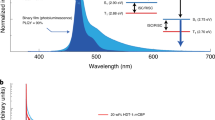Abstract
Organic light-emitting diodes (OLEDs) are developing into a competitive alternative to conventional light sources. Nevertheless, OLEDs need further improvement in terms of efficiency and color rendering for lighting applications. Fluorescent blue emitters allow deep blue emission and high stability, while phosphorescent blue emitter still suffer from insufficient stability. The concept of triplet harvesting is the key for achieving internal quantum efficiencies up to 100 % and simultaneously benefiting from the advantages of fluorescent blue emitters. Here, we present a stacked OLED consisting of two units comprising four different emitters in total. The first unit takes advantage of the concept of triplet harvesting and combines the light emission of a fluorescent blue and a phosphorescent red emitter. The second unit emits light from a single emission layer consisting of a matrix doped with phosphorescent green and yellow emitters. With this approach, we reach white color coordinates close to the standard illuminant A and a color rendering index of above 75. The presented devices are characterized by high luminous efficacies of above 30 lm/W on standard glass substrates without outcoupling enhancement.
Similar content being viewed by others
References
Reineke, S., Lindner, F., Schwartz, G., Seidler, N., Walzer, K., Lüssem, B., and Leo, K., “White organic light-emitting diodes with fluorescent tube efficiency,” Nature 459, 234 (2009).
Nakayama, T., Hiyama, K., Furukawa, K., and Ohtani, H., “Development of phosphorescent white OLED with extremely high power efficiency and long lifetime,” SID07 Dig. , 1018 (2006).
Lee, J.-I., Chu, H. Y., Yang, Y. S., Do, L.-M., Chung, S. M., Park, S.-H. K., and Hwang, C.-S., “Harvest of triplet excitons in fluorescence emission layer based on a wide band gap host of TcTa for efficient white organic light emitting diodes,” Proc. SPIE 6655, 66550I (2007).
Schwartz, G., Reineke, S., Rosenow, T. C., Walzer, K., and Leo, K., “Triplet harvesting in hybrid white organic light-emitting diodes,” Adv. Func. Mater. 19, 1 (2009).
Schwartz, G., Reineke, S., Walzer, K., and Leo, K., “Reduced efficiency roll-off in high-efficiency hybrid white organic light-emitting diodes,” Appl. Phys. Lett. 92, 05331 (2008).
Liao, L. S., Klubek, K. P., and Tang, C. W., “High-efficiency tandem organic light-emitting diodes,” Appl. Phys. Lett. 84, 167 (2004).
Kanno, H., Hamada, Y., Nishimura, K., Okumoto, K., Saito, N., Ishida, H., Takahashi, H., Shibata, K., and Mameno, K., “High efficiency stacked organic light-emitting diodes employing Li2O as a connecting layer,” Jap. J. Appl. Phys. 45, 9219 (2006).
Baldo, M. A., Adachi, C., and Forrest, S. R., “Transient analysis of organic electrophosphorescence. II. transient analysis of triplet-triplet annihilation,” Phys. Rev. B 62, 10967 (2000).
He, G., Pfeiffer, M., Leo, K., Hofmann, M., Birnstock, J., Pudzich, R., and Salbeck, J., “High-efficiency and low-voltage p-i-n electrophosphorescent organic light-emitting diodes with double-emission layers,” Appl. Phys. Lett. 85, 3911 (2004).
CIE, [Commission internationale de l’éclairage proceedings 1924], Cambridge University Press, Cambridge (1926).
Sun, Y., Giebink, N. C., Kanno, H., Ma, B., Thompson, M. E., and Forrest, S. R., “Management of singlet and triplet excitons for efficient white organic light-emitting devices,” Nature 440, 04645 (2006).
Kondakova, M. E., Deaton, J. C., Pawlik, T. D., Giesen, D. J., Kondakov, D. Y., Young, R. H., Royster, T. L., Comfort, D. L., and Shore, J. D., “Highly efficient fluorescent-phosphorescent triplet-harvesting hybrid organic light-emitting diodes,” J. Appl. Phys. 107, 014515 (2010).
Author information
Authors and Affiliations
Corresponding author
Rights and permissions
About this article
Cite this article
Rosenow, T.C., Olthof, S., Reineke, S. et al. Four color stacked white organic light-emitting diodes utilizing the concept of triplet harvesting. MRS Online Proceedings Library 1286, 101 (2010). https://doi.org/10.1557/opl.2011.3
Published:
DOI: https://doi.org/10.1557/opl.2011.3




